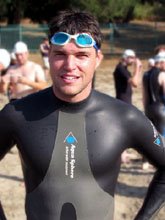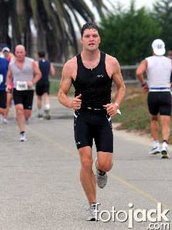There's a lot of dogma around the subject of strength and conditioning, most likely because of all the
gurus and hangers-on that swarm around the fitness field. Even the average non-gym goer can rattle off a list of the top fitness crazes that have periodically swept the nation like angry locusts over the last decades: aerobics, core training, Tae Bo, Pilates, spinning, yoga, Step... a new religion crops up every few years, led by the requisite charismatic carnival-barker, reinventing the wheel with a vengeance.
In the field of weight training, the same advice has been repeated so often it's almost exhausting to write it: "Do three sets of 8-12 reps to failure of exercises for all your major body parts. After a few months, divide your body into sections, as if you were the Frankenstein monster, and work one section a day so that you're working every muscle group over the course of a week."
I've got a beer in front of me, so I guess that means I'm officially drinking and blogging here, but in the permissive State of California, that's not a crime...so stick with me.
I've mentioned
Chad Waterbury before, and I'm mentioning him again because amidst the faithful, he's an iconoclast. He's got a book called
MUSCLE REVOLUTION that, for fitness geeks like myself, is a blast of fresh salt-breeze across the bow of a ship stuck in the doldrums.
Among Chad's more out-there concepts is that it's possible to work a muscle group not just once, not twice or even three times a week. In a program he calls "Perfect 10," he argues that you can work a muscle group TEN times a week for a limited period and still experience growth and improvement. He's got a month-long program just out that, if I'm reading it right, postulates that you can work your entire body seven days a week for a month and STILL experience excellent progress.
I'll give you a moment to get off the floor, since I know you've just fallen out of your chair, just like I did when I first read his book. Waterbury has taken some of the most basic assumptions of strength training and conditioning and rather casually turned them on their ear. Personally I say, it's about time.
Of course, there are iconoclasts whose ideas are field tested and scientifically sound, and there are others who make outlandish claims simply to hear themselves bark. So I recently decided to do some very informal field-testing of my own.
During the months that I was training for my last triathlon (see photo at right), I was doing almost no strength training on a regular basis outside of loading and unloading clients' barbells. So, inspired by Waterbury, I decided to try a
Milo-of-Crotona-style experiment: once a day, when I had ten minutes at the gym I'd do the following, brief upper body workout:
One set of
dragon-flag leg raises
One set of as many dips as I could
One set of as many underhand-grip pullups as I could
A second set of dragon-flag leg raises.
I did this brief upper-body only workout (my legs were always fried from all the running and biking I was doing) about five days a week for about a month. My goal with each workout was simple: increase the number of reps on pull-ups and dips by a single repetition every day. I wasn't worried about reps on the dragon-flag leg raises; I just tried to get better at doing them. Check out the video -- they're tough.
Strength-training dogmatists would have any number of criticisms for this workout. The typical recommendation is not to train a muscle group more than three times a week, and to train with multiple sets falling in the 8-12 range. By those standards, my training frequency was way too high (5 days a week); my volume way too low (one set per exercise); my reps (over 15) too high to generate any meaningful increases in strength or muscle size.
But I thought of the the guy who invented the malaria vaccine, the man who risked death by injecting himself with his own formula, and forged ahead. It was a daring mission. A fellow trainer I knew,
Karen Williams, got wind of what I was trying to do and even started yelling encouragement at me whenever she saw me gearing up for my 10-minute new/old-school muscle blast.
The result? Well, surprisingly good. There were some days when I couldn't get the extra rep and stayed where I'd been the previous day; others where I'd backslide a bit. But all told, I set personal records in both exercises: 26 pull-ups and 28 dips on the day that the insanity ended, when at last I regained my sanity and ceded to the "FREE ANDREW" signs that concerned members had posted all around the gym. As an added bonus, my swimming speed, which is in part, a function of upper-body strength and endurance, improved dramatically.
Now, I remember going to some county fair where they had a Marine Corps recruitment station with a chin-up bar set up, and seeing some soldier crank out something along the lines of 50 chin-ups. And there are guys who can do 100 dips without breaking a sweat. So on an absolute scale, these numbers mean little.
But to me, the importance of these numbers is not that they give me 'bragging rights' to anything special (which is good, because they're not that much to brag about anyway). Science purists--first cousins to the dogmatists--will tell me not to draw conclusions based on my "study": my sample size was too small, my experiment duration too short. Chad Waterbury, himself a scientist, might legitimately protest that I wasn't even following one of his many carefully-crafted programs, so what business do I have invoking him here?
From a science perspective, I'm in total agreement: there hasn't been a study so flawed since those four out of five dentists recommended sugarless gum. Still, before my experiment I would have believed the textbooks: that anyone following such a program would not only lose strength and size, but would very likely injure themselves as well. Instead, the opposite happened: I got stronger and bigger, and, the results had real-world, sports-specific carry-over.
If I had to guess, I'd postulate that the optimal rest between workouts for a given muscle group or movement is based not on a hard number, such as the the oft-cited 48 hours, but varies based on the duration, volume and intensity of the workout, and, lest we forget, on the physiology of the individual athlete. The best workout programs hit the sweet spot between stimulation and recovery, so that a muscle group is re-stimulated just as those muscles have completely recovered from the previous workout.
Conventional wisdom holds that poor workout programs fail because they work the muscles
•too hard, too often, leading to over-training;
•too hard, too infrequently, leading to excessive soreness and possible injury; or
•not hard enough and not often enough, leading to no improvement.
That leaves "not hard enough and too often," which, without realizing it at the time, was exactly what I was road-testing: just one tough-but-doable set per muscle group, performed a whopping five days a week.
Most strength-training programs advance by upping intensity and volume while lowering frequency, leading to the Frankensteinian templates, cited by most bodybuilding magazines, where you do 15 sets for biceps on Monday, 20 sets for shoulders on Tuesday, and so on. My mini-workout program here does the opposite: relative to traditional strength training programs, my volume was lower but my frequency much higher.
Of course, you've got to throw into the mix that I was also doing about 7 hours a week of running, biking, and swimming workouts, plus several hours a day of handing clients weights, loading and unloading barbells, and generally skulking around the gym. So maybe this abbreviated workout was all the additional stress my body could handle, and under different circumstances my results would have been vastly different. The only legitimate conclusion to draw is that, for whatever reason, this unusual combination of volume, intensity and frequency approached the stimulation/recovery 'sweet spot' for this particular athlete at this particular phase in his training life.
Still, this inevitably makes me wonder whether there are other athletes out there who might get equal or greater benefit from a low-intensity, high-frequency program like this one.
Imperfect as my experiment was, to me, the results were further evidence that some of the very basic assumptions about strength and conditioning training may need serious reevaluation. Iconoclasts unite.

 Then imagine that if a gym for teens became a cool hangout -- and from the pictures and marketing materials, it looks like it has the potential to be VERY cool -- it could turn teen pack mentality to parents' advantage. Then let's talk about the dismal state of physical education in this country and how a gym for teens might be able to play a small part in rectifying that. And on and on.
Then imagine that if a gym for teens became a cool hangout -- and from the pictures and marketing materials, it looks like it has the potential to be VERY cool -- it could turn teen pack mentality to parents' advantage. Then let's talk about the dismal state of physical education in this country and how a gym for teens might be able to play a small part in rectifying that. And on and on. they work out. They could take a martial arts or a yoga class with ten of their friends, then sidle up to the protein bar for a smoothie. Better that than smoking in the boys' room.
they work out. They could take a martial arts or a yoga class with ten of their friends, then sidle up to the protein bar for a smoothie. Better that than smoking in the boys' room.


